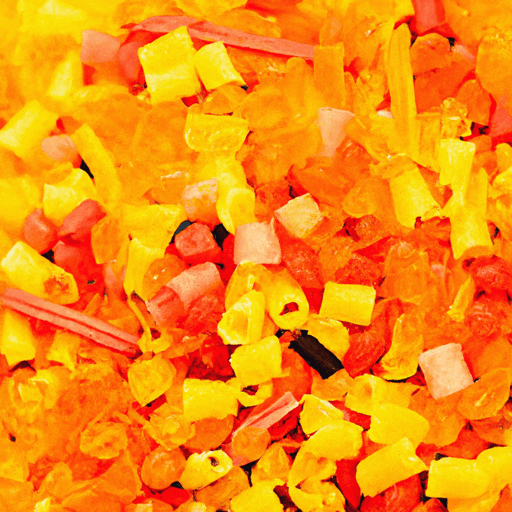All About Candy Melting Wafers: A Sweet Delight for Cooking Enthusiasts
Candy melting wafers, also known as candy melts or confectionery coating, are a versatile treat widely used in the culinary world. These delightful morsels are the go-to choice for bakers, chocolatiers, and cooking enthusiasts looking to add a touch of sweetness and creativity to their culinary creations. In this blog post, we’ll explore the appealing taste, common uses, nutritional value, and share some interesting history and facts about candy melting wafers.
The Irresistible Taste of Candy Melting Wafers
Candy melting wafers offer a delectable sweetness that melts in your mouth, leaving a delightful burst of flavors. Available in a wide range of flavors, including vanilla, chocolate, strawberry, mint, and even exotic options like coconut or salted caramel, these wafers bring a diverse palette of tastes to your recipes. Whether you’re a fan of classic flavors or eager to experiment with unique combinations, there’s a candy melting wafer flavor to satisfy every craving.
Versatility at Its Finest: Common Uses in Cooking
One of the most significant advantages of candy melting wafers is their versatility in the kitchen. These delightful treats open up a world of possibilities for creative culinary ventures. Here are some popular uses for candy melting wafers:
- Dipping and Coating: Candy melts excel at coating cookies, pretzels, fruits, and other delectable treats. They offer a smooth and glossy finish that adds a touch of charm to any dessert.
- Decorations: Crafters and bakers adore candy melts for their ability to harden quickly. This makes them perfect for creating intricate decorations, such as cake pops, molded chocolates, or ornamental designs atop cupcakes.
- Drizzling: Melted candy wafers can be beautifully drizzled over cakes, cookies, or brownies, instantly transforming them into visually stunning and delicious treats.
- Mold Fillings: When filled into candy or chocolate molds, these wafers create lovely and flavorful homemade chocolates.
- Dessert Dipping Stations: Candy melting wafers are ideal for setting up delightful dessert dipping stations at parties or gatherings. Offer an array of fruits, cookies, and other treats, and let guests dive into a colorful, chocolate-coated wonderland.
Nutritional Value: A Sweet Treat with Moderation in Mind
When indulging in candy melting wafers, it’s good to be mindful of their nutritional value. While these treats are undoubtedly enjoyable, it’s important to consume them in moderation. Candy melting wafers are typically made from a combination of sugar, vegetable oils, and artificial flavorings. They are considered a confectionery treat rather than a health food. However, they are generally gluten-free, making them suitable for those with gluten sensitivities.
A Brief History and Noteworthy Facts
Candy melting wafers have an intriguing backstory. They were originally developed as a convenient alternative to tempered chocolate. These wafers gained popularity because they eliminate the need for tempering, a process that requires precise temperature control and can be challenging for home cooks. Candy melts were originally introduced in the 1940s for use in commercial baking but quickly found their way into the hands of home cooks and amateur chocolatiers.
Interesting facts about candy melting wafers:
- Candy melts can be easily melted in the microwave, making them convenient for quick creations.
- They are known for their vibrant and vivid colors, allowing for endless creativity in dessert decorating.
- With proper storage, candy melting wafers have an impressive shelf life, making them an excellent pantry staple for impromptu baking sessions.
Whether you’re a culinary artist, a passionate home cook, or simply someone with a sweet tooth, candy melting wafers are an essential ingredient to have in your pantry. Their versatility, vibrant flavors, and ease of use make them a delightful addition to any culinary creation. So, go ahead, unleash your creativity and dive into the sweet and colorful world of candy melting wafers!
Candy Melting Wafers
Origin: Candy melting wafers, also known as candy melts or chocolate coating, were invented by confectionery company Peter’s Chocolate in the 1940s. They were initially developed as a convenient alternative to tempering chocolate for coating and dipping confections.
Common Uses: Candy melting wafers are widely used in candy making and confectionery projects. They are frequently used to coat cake pops, cookies, pretzels, fruits, and other treats. These wafers provide a smooth and glossy finish and are available in a wide range of colors and flavors, making them popular for decorative purposes.
Nutritional Benefits: Candy melting wafers primarily consist of vegetable fats, sugar, and powdered milk. They are not considered a source of significant nutritional benefits. It’s worth noting that the nutritional profile can vary depending on the specific brand and formulation.
Unique Properties: Candy melting wafers have a unique property called “tempering.” This means that they can be melted and cooled without the need for tempering, which is required with pure chocolate. It allows for easier handling and ensures a smoother final finish. Additionally, these wafers offer a longer shelf life compared to real chocolate.
Historical Significance: The invention of candy melting wafers revolutionized confectionery industry practices. Prior to their creation, tempering chocolate was a time-consuming process that required specific temperature control. Candy melts provided a simpler and more convenient alternative, enabling home cooks and professional bakers to achieve professional-looking results in less time.
Please note that while candy melting wafers are commonly referred to as chocolate, they are not real chocolate due to the absence of cocoa butter.




Use the share button below if you liked it.
It makes me smile, when I see it.